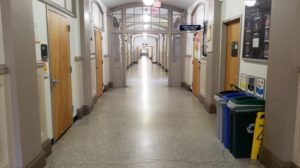The phrase “online learning” is an oxymoron. Since COVID-19 began, Camosun classes are mostly online, forcing instructors and students to adapt to streaming Zoom lectures and using online platforms like D2L. There’s a reason why online courses are usually cheaper: it’s an inferior environment for learning. Despite this, students are still paying full tuition for classes that are bumbling circuses of ineffectiveness.
To understand why online learning is so inefficient, it’s necessary to establish why in-person classes work so well. The process of education is a bit like live theatre: it’s bidirectional. An actor presents an experience to the audience, who interacts through their reactions and collective energy.
In a classroom, students form an audience to the instructor, and there’s an energetic connection between them. Even disengaged students whom professors may categorize as “brick walls” still bring energy into the room, and when students and instructors are actively engaged with each other, they create a synergistic relationship.
Online courses cleave that connection. Everyone is distanced, talking to tiny squares on their monitors. Consequently, that synergy is missing, and communication and creativity plummet.

Since libraries and classrooms have been shut down, students are likely streaming from their homes, or the few public wi-fi spots still open. Studying from home means you can’t separate work and school, and public cafes are noisy and chaotic. A dedicated learning environment is crucial for creating an atmosphere of success.
This energetic impedance impacts the professors, too. I’ve found Zoom lectures to be drawn out and unfocused, with little productive content, which can be exacerbated by asynchronous prerecorded videos within which the instructor is merely talking to a webcam. These lectures stagger like zombies of their former selves.
And that’s assuming you can even view them. The new format completely excludes people who have no internet connection, other than limited mobile data, at home. Even with internet, the connection is frequently sketchy, resulting in hitches or worse. This can cause information loss and create problems during live graded exams and quizzes. Imagine that you’re sitting at your desk in class, and in the next moment you’re miles away in an empty space. Congratulations: Zoom just dropped your call. That appointment wasn’t important anyway, right?
The administration of course content online is unengaging, also. Unlike physical media, online readings feel like they don’t even exist, and the desire to engage with digital schoolwork is further stifled by confusing, poorly designed platforms often resulting in students having difficulty even accessing their work, let alone completing it.
Additionally, part of the benefit of school is being in an environment where you can connect with your peers organically, but in online classes, even basic interaction is stilted and awkward. We’re social beings, but we’re separated from each other. It was already difficult to make meaningful connections when there was no physical hindrance; now, it’s almost impossible.
I wanted to examine these deficiencies and find ways to improve them in this piece, but I can’t. It’s analogous to a strange game of Ping-Pong where I stand back and verbally direct the players to move their hands for each motion. I think, “How can this work better?” But I don’t think it can. The flaws are too deeply ingrained.
Online learning is worse for everyone involved, except for the college, which still receives full tuition in exchange for a sub-par learning experience.
